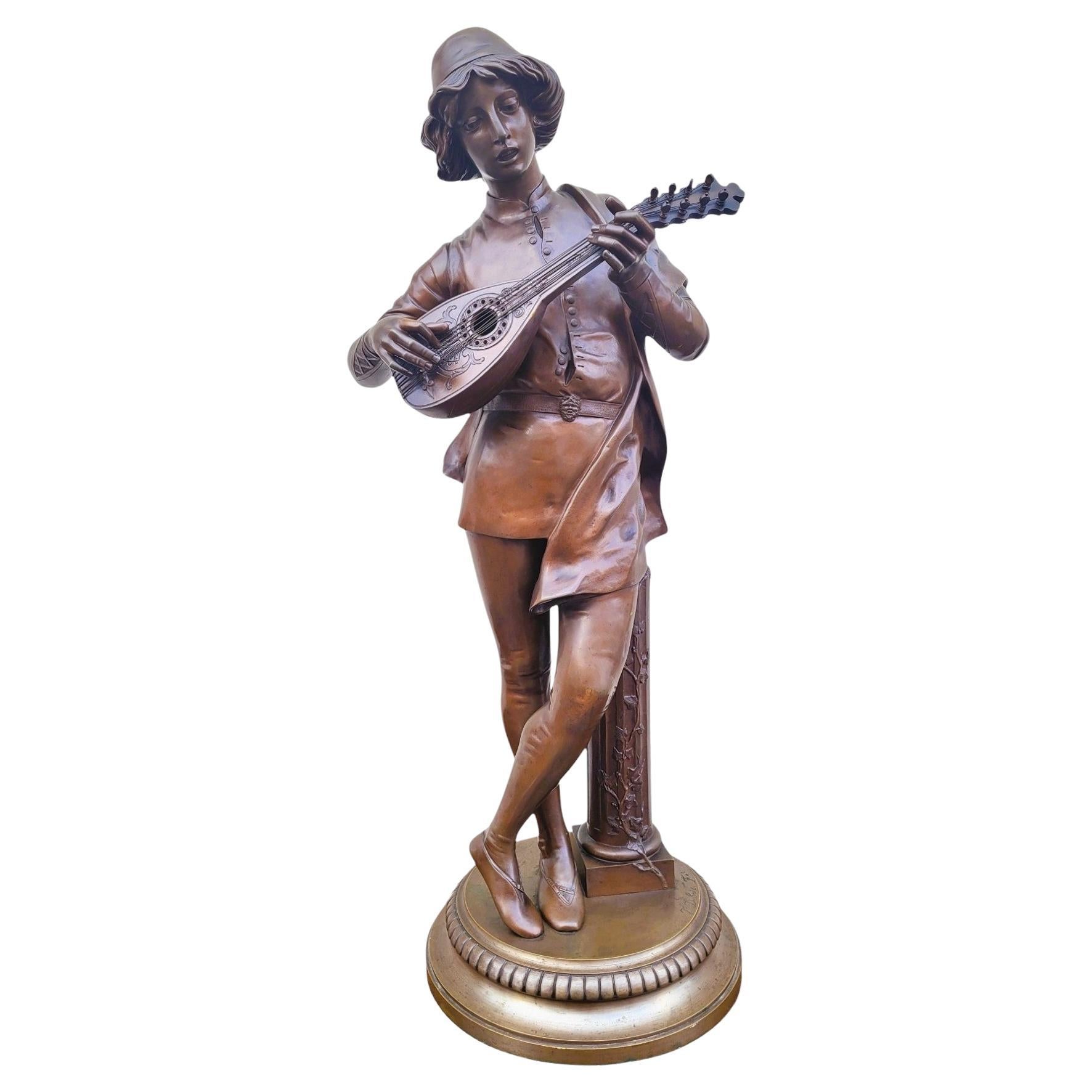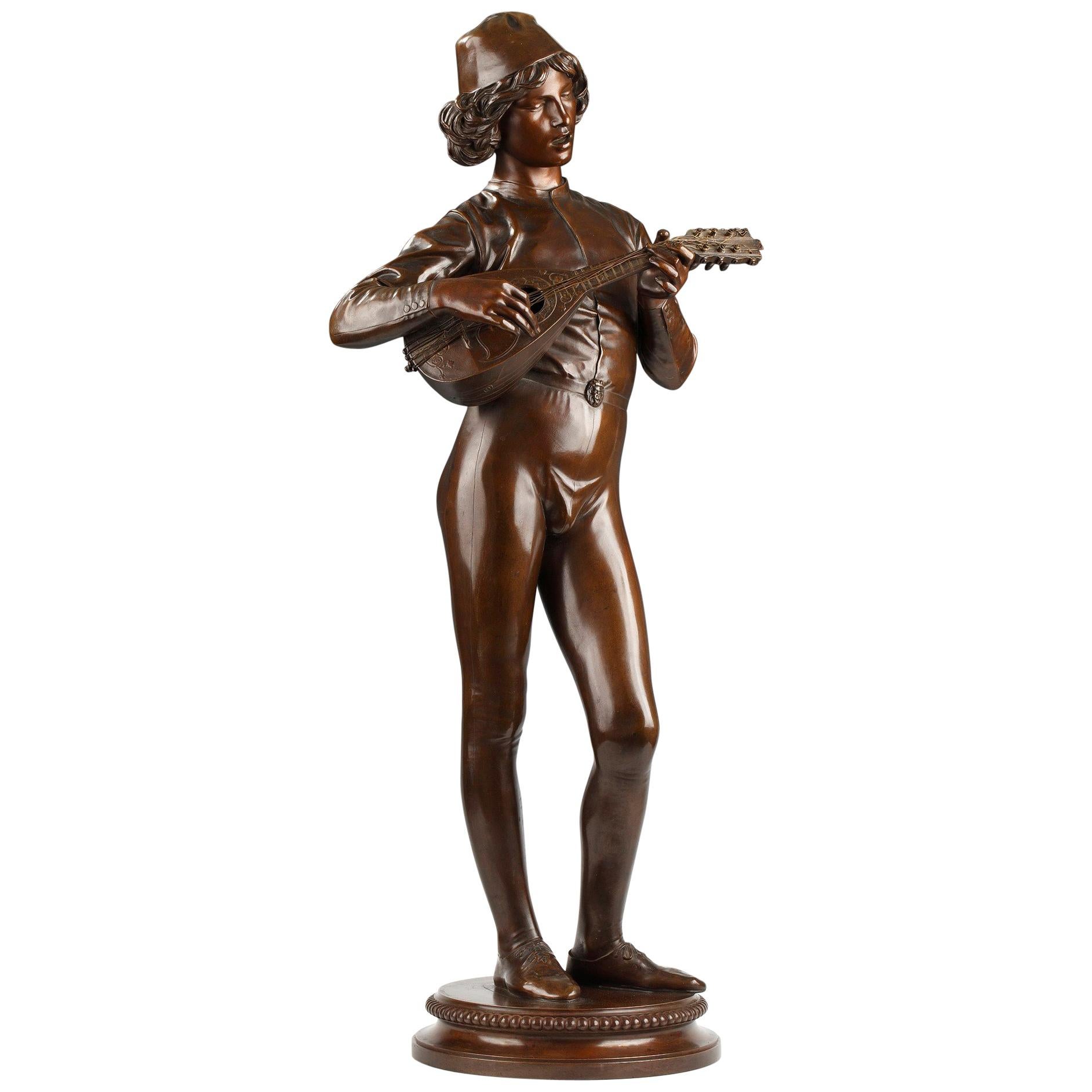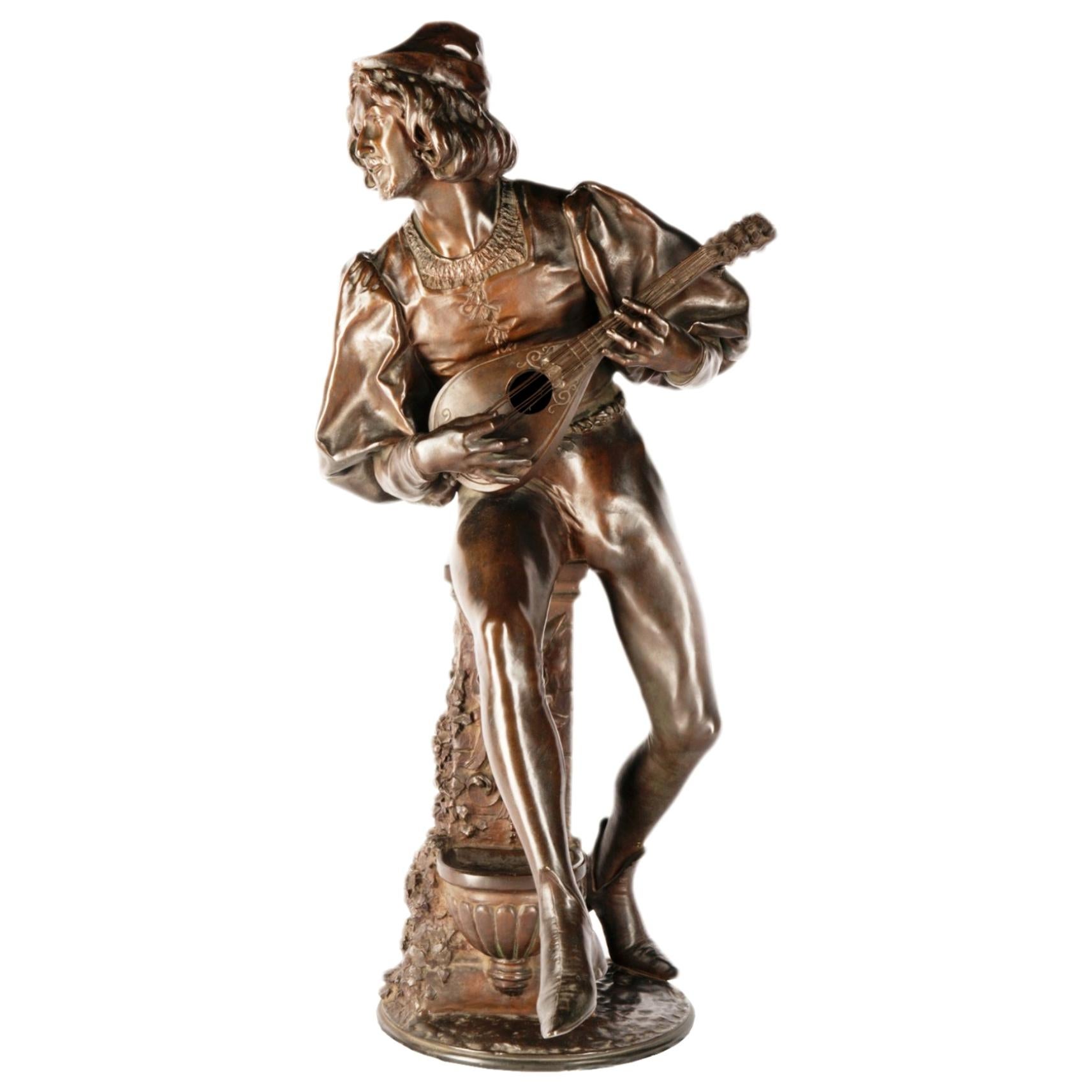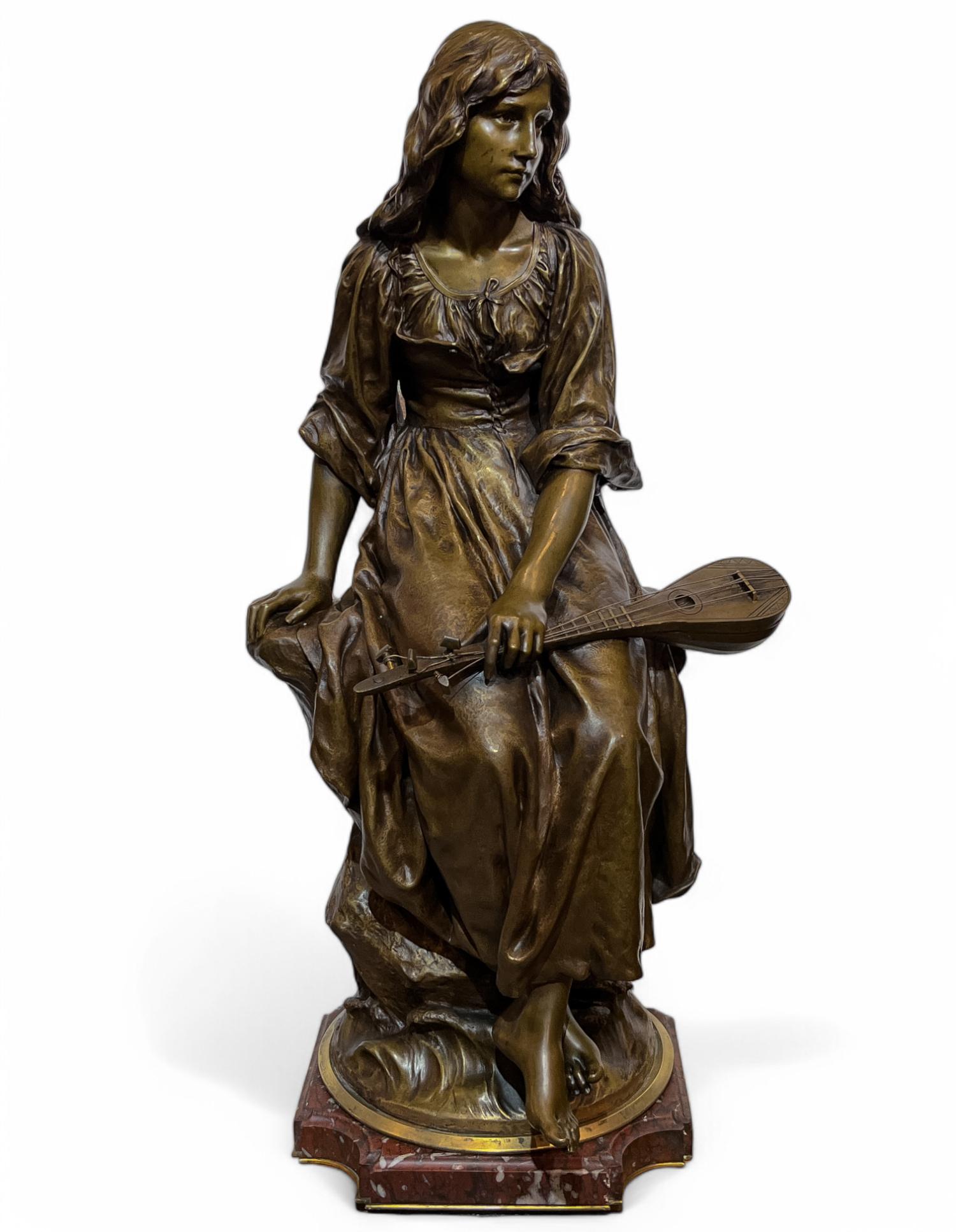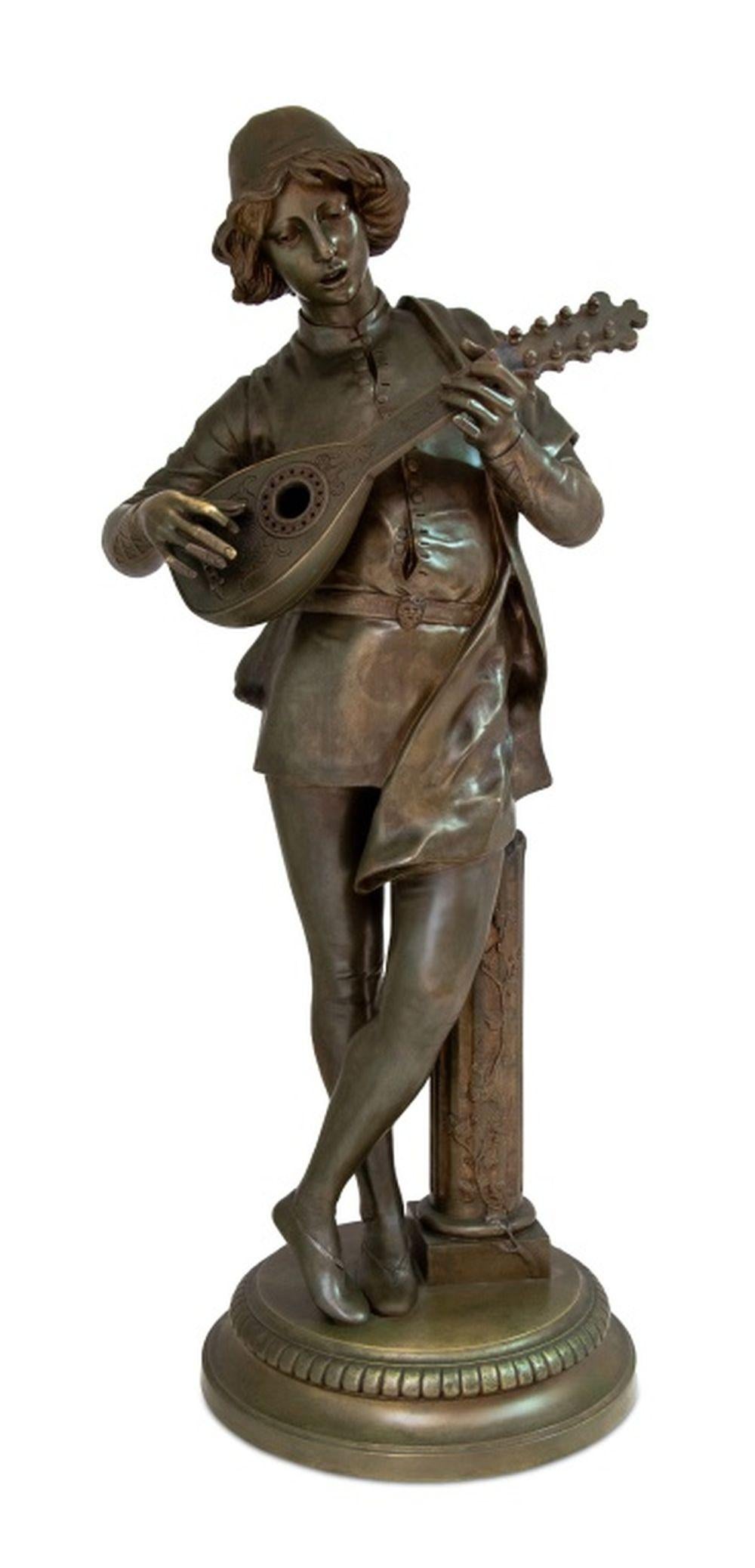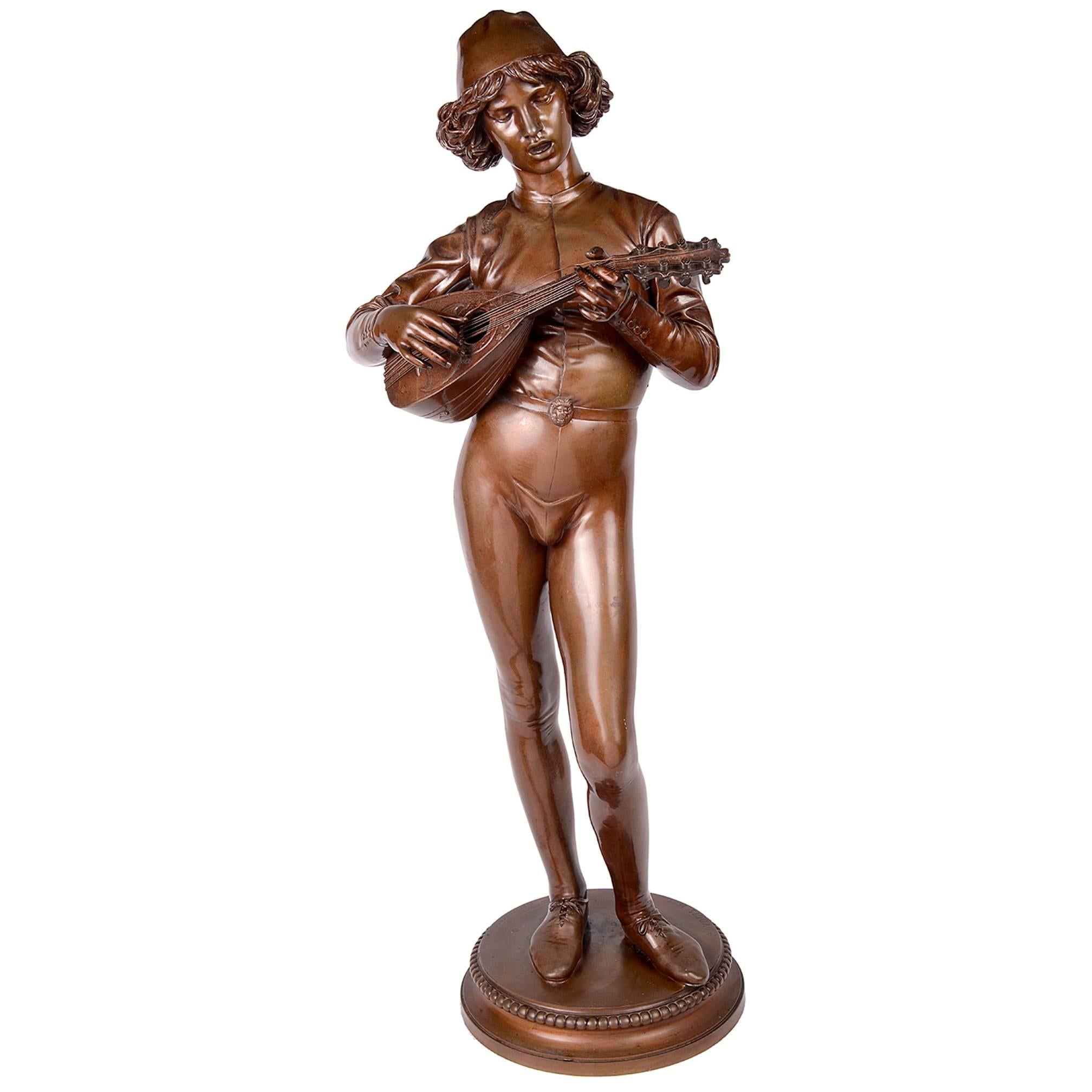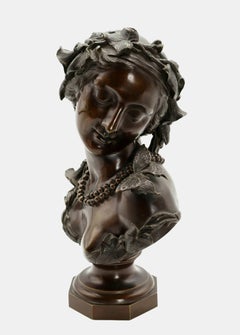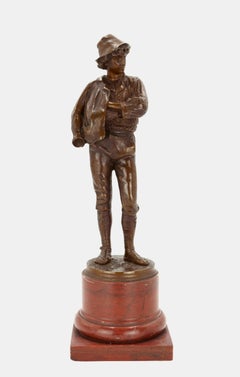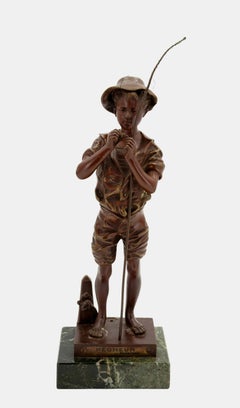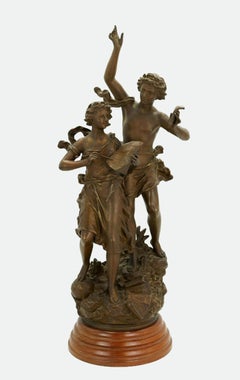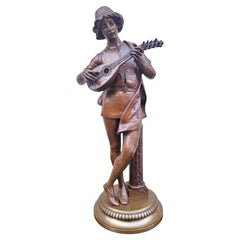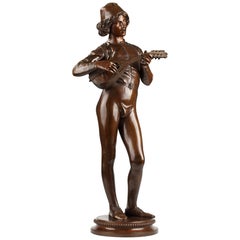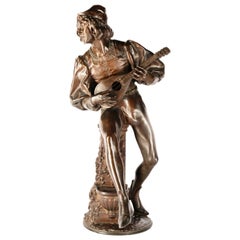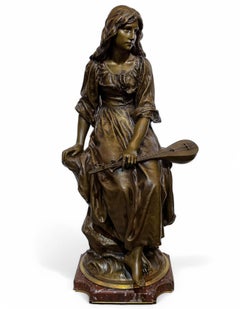Items Similar to Florentine singer / - The Renaissance of the Renaissance -
Want more images or videos?
Request additional images or videos from the seller
1 of 12
Paul DuboisFlorentine singer / - The Renaissance of the Renaissance -1865
1865
$4,268.14
$5,335.1820% Off
£3,194.25
£3,992.8120% Off
€3,600
€4,50020% Off
CA$5,888.28
CA$7,360.3520% Off
A$6,548.01
A$8,185.0120% Off
CHF 3,439.16
CHF 4,298.9420% Off
MX$80,055.97
MX$100,069.9620% Off
NOK 42,855.18
NOK 53,568.9720% Off
SEK 40,400.86
SEK 50,501.0720% Off
DKK 27,404.99
DKK 34,256.2320% Off
About the Item
Paul Dubois (1829 Nogent-sur-Seine - 1905 Paris), Florentine singer, 1865. Light brown patinated bronze with cast round plinth mounted on a square marble base (3.5 cm high). Total height 53 cm. Bronze dimensions: 49.5 cm (height) x 20 cm (length) x 10 cm (width), weight 5.6 kg. Inscribed on the plinth "P.[aul] DUBOIS", dated "1865", with the foundry's mark "F. BARBEDIENNE FONDEUR" and the signet "REDUCTION MECANIQUE A. COLLAS".
- Patina very occasionally darkened, lute with loss of one tuning peg, otherwise in excellent condition.
- The renaissance of the Renaissance -
The bronze is a precisely executed and masterfully cast contemporary reduction of Paul Dubois 155 cm tall masterpiece "Florentine Singer", which is exhibited in the Musée d'Orsay and for which the artist was awarded the Medal of Honor at the Paris Salon in 1865. The work acted as a beacon, and was followed by a plethora of depictions of juveniles.
Inspired by Donatello and Luca della Robbia, but also by painters such as Piero della Francesca, Benozzo Gozzoli, and Pinturicchio, the "Florentine Singer" is not an epigonal work that pays homage to a vanished era, but a successful attempt to draw vitality from the art of the past and thus give it new life.
The effect of vitality is the core of Italian Renaissance art theory. In order to fulfill itself as art, art had to appear like nature. This naturalism also characterizes the "Florentine Singer". The young man appears to have been taken from life, which is reinforced by the momentary nature of his action. He has just struck a now fading chord. In addition, the natural appearance is enhanced by the detailed shaping of the figurative details, such as the laces with the slightly curved leather of the shoes, the belt buckle, or the ornamentation on the body of the lute. Even the fingernails are clearly defined. Unlike the Renaissance, however, the effect of liveliness here is not based on the "discovery" of nature and the human body, but primarily on the rediscovery of the art of the Quattrocento. The liveliness of the artwork is therefore at the same time a revitalization of this art, so that we can speak of a Renaissance of the Renaissance, just as the Pre-Raphaelites in England at the same time transferred the Quattrocento to contemporary art.
Dubois takes on the most difficult of all subjects, the depiction of singing through silent sculpture. He was preceded in this by Luca della Robbia and Donatello with their pulpits of singers created in the 1430s in the Museo dell'Opera del Duomo in Florence. Compared to these works, the physiognomy of Dubois singer is far less animated, yet he also depicts singing in a convincing manner. He uses the whole body. He takes the ancient contrapposto, which was essential to Renaissance sculpture, and transforms the standing leg-playing posture into a late medieval S-swing, giving the body an elegant beauty and at the same time setting it in melodic motion. In the equally elegant finger position, the music is expressed in a much more literal way with the beating of the lute. Finally, the musicality of the sculpture culminates in the face with the mouth open to sing.
Through the act of singing, which is a great challenge to the artistic will to depict perfect beauty, the gracefulness of the classical face is not diminished, but enhanced. Starting from the face with the singing mouth and the gaze absorbed by the sounds, the inner vitality spreads, giving the bronze sculpture an intense aura, enhanced by the music. Dubois transfers the beauty of the Renaissance to the musical, sublimating the visible sculpture to the invisible of music.
He took up the challenge of transcending the Renaissance with the Renaissance, thus responding to the Querelle des Anciens et des Modernes, which arose at the end of the 17th century around the French Academy and remained virulent into the 19th century, in which antiquity was regarded either as an unattainable ideal or as a standard to be surpassed. With his work, Dubois proved that the Renaissance, which had championed the art of the ancients, could lead to a new renaissance of art.
About the artist
Paul Dubois' great-uncle was the famous French Baroque sculptor Jean-Baptiste Pigalle, in whose footsteps the talented great-nephew followed. When he debuted at the Paris Salon in 1858, he signed his work "Dubois-Pigalle". At his father's request, however, he first studied law before devoting himself to sculpture under the tutelage of François Christophe Armand Toussaint in 1856 and entering the École des Beaux-Arts in 1858. From 1859 to 1863, he lived in Rome and traveled to Naples and Florence. Inspired by Florentine art of the quattrocento, Dubois initiated a school-forming neo-Florentine style that combined the elegantly simple forms of youthful grace with a precise wealth of detail.Two purchases by the French state (“envois de Rome”) were made during his stay in Rome, which brought him recognition in Paris. After his return there, he quickly became an internationally sought-after artist.
Dubois was also active as a creator of monuments. His most famous work is the equestrian statue of Joan of Arc (1896) on the forecourt of Reims Cathedral. He was also a sought-after portraitist who produced around 50 busts and - Dubois was also a passionate painter - around 100 portraits in oil.
From 1873 to 1878 he was curator of the Museum du Luxembourg, in 1876 he became a member of the Institut de France and from 1878 to 1905 he was director of the École des Beaux-Arts.
In 1865, Dubois was awarded the Paris Salon Medal of Honor for his “Florentine Singer”. In 1867 he became Chevalier, in 1874 Officier, in 1886 Commandeur of the Légion d'honneur, which awarded Dubois the Grande Croix in 1896.
Selected Bibliography
Stole, Elmar: Paul Dubois. In: Saur. Allgemeines Künstlerlexikon, vol. 30, Munich - Leipzig 2001, pp. 677-678.
GERMAN VERSION
Paul Dubois (1829 Nogent-sur-Seine - 1905 Paris), Florentinischer Sänger, 1865. Hellbraun patinierte Bronze mit gegossener runder Plinthe auf quadratischem Marmorsockel montiert (3,5 cm Höhe). Gesamthöhe 53 cm. Maße der Bronze: 49,5 cm (Höhe) x 20 cm (Länge) x 10 cm (Breite), Gewicht 5,6 kg. Auf der Plinthe mit „P.[aul] DUBOIS“ bezeichnet, auf „1865“ datiert, mit dem Gießereistempel „F. BARBEDIENNE FONDEUR“ und dem Signet „REDUCTION MECANIQUE A. COLLAS“ versehen.
- Patina sehr vereinzelt nachgedunkelt, Laute mit Verlust eines Stimmwirbels, ansonsten ausgezeichnet erhalten.
- Die Renaissance der Renaissance -
Bei der Bronze handelt es sich um die präzise ausgeführte und meisterhaft gegossene zeitgenössische Reduktion von Paul Dubois‘ im Musée d’Orsay ausgestelltem, 155 cm hohen Hauptwerk „Florentinischer Sänger“, für welches dem Künstler im Pariser Salon 1865 die Ehrenmedaille verliehen wurde. Das Werk wirkte wie ein Fanal, in dessen Nachfolge eine Fülle an Jünglingsdarstellungen geschaffen wurden.
Der von Donatello und Luca della Robbia, aber auch von Malern wie Piero della Francesca, Benozzo Gozzoli und Pinturicchio inspirierte „Florentinische Sänger“ ist kein epigonales Werk, das einer untergegangenen Epoche huldigt, sondern der gelungene Versuch, die Lebendigkeit aus der Kunst der Vergangenheit herauszuschöpfen und ihr dadurch ein neues Leben zu verleihen.
Die Lebendigkeitswirkung ist der Kern der italienischen Kunsttheorie der Renaissance. Um sich als Kunst zu erfüllen, hatte die Kunst wie die Natur zu erscheinen. Dieser Naturalismus zeichnet auch den „Florentinischen Sänger“ aus. Der Jüngling wirkt wie aus dem Leben gegriffen, was durch das Augenblickhafte seiner Handlung noch gesteigert wird. Er hat gerade einen nunmehr verklingenden Akkord angeschlagen. Zudem wird die naturgemäße Erscheinung durch die äußerst detaillierte Ausformung gegenständlicher Einzelheiten gesteigert, wie die Schnürenkel mit dem leicht aufgewölbten Leder der Schuhe, der Gürtelschnalle oder der Ornamentik am Korpus der Laute. Selbst die Fingernägel sind klar definiert. Im Gegensatz zur Renaissance beruht die Lebendigkeitswirkung hier jedoch nicht auf der „Entdeckung“ der Natur und des menschlichen Körpers, sondern in erster Linie auf der Wiederentdeckung der Kunst des Quattrocento. Die Lebendigkeit des Kunstwerks ist also zugleich eine Wiederverlebendigung dieser Kunst, so dass von einer Renaissance der Renaissance gesprochen werden kann, ganz so, wie die Präraffaeliten zur selben Zeit in England das Quattrocento in die gegenwärtige Kunst überführen.
Dubois nimmt sich des schwierigsten aller Sujets an, der Darstellung des Gesangs durch die stumme Skulptur. Darin gingen ihm Luca della Robbia und Donatello mit ihren in den 1430er Jahren geschaffenen Sängerkanzeln im Museo dell’Opera del Duomo in Florenz voraus. Im Vergleich zu diesen Werken ist die Physiognomie des Sängers von Dubois‘ weit unbewegter und doch veranschaulicht auch er das Singen auf überzeugende Weise. Dazu hat er sich des gesamten Körpers bedient. Er greift den für die Skulptur der Renaissance wesentlichen antikischen Kontrapost auf und überführt die Standbein-Spielbein-Haltung in einen spätmittelalterlichen S-Schwung, wodurch der Körper eine äußerst elegante Schönheit aufweist und zugleich in eine melodische Bewegung versetzt wird. In der ebenfalls eleganten Fingerhaltung kommt mit dem Schlagen der Laute die Musik auf weit wörtlichere Weise zum Ausdruck. Im Gesicht schließlich mit dem zum Gesang geöffneten Mund kulminiert die Musikalität der Skulptur.
Durch den Akt des Singens – und dies ist eine besonders große Herausforderung für den künstlerischen Willen, vollendete Schönheit darzustellen – wird die Anmut des klassischen Antlitzes nicht beschnitten, sondern noch gesteigert. Ausgehend vom Gesicht mit dem singenden Mund und dem von den Klängen absorbierten Blick verbreitet sich die innere Lebendigkeit, die der Bronzeplastik eine von der Musik verstärkte intensive Aura verleiht. Dubois transferiert die Schönheit der Renaissance ins Musikalische und sublimiert die sichtbare Skulptur ins Unsichtbare der Musik.
Er hat sich der Herausforderung angenommen, mit der Renaissance über die Renaissance hinauszugehen und damit nachträglich den im ausgehenden 17. Jahrhundert im Umfeld der französischen Akademie entfachten, bis ins 19. Jahrhundert virulenten Querelle des Anciens et des Modernes beantwortet, bei dem die Antike entweder als unerreichbares Ideal oder als zu überflügelnder Maßstab gesehen wurde. Mit seinem Werk hat Dubois den Beweis angetreten, dass gerade aus der für die Kunst der Alten einstehenden Renaissance eine Renaissance der Kunst eröffnet werden kann.
zum Künstler
Paul Dubois‘ Großonkel war der berühmte französische Barock-Bildhauer Jean-Baptiste Pigalle, in dessen Fußstapfen der talentierte Großneffe trat. Bei seinem Debüt im Pariser Salon, 1858, signierte er mit „Dubois-Pigalle“. Auf Wunsch des Vaters studierte er jedoch zunächst Jura bevor er sich 1856 unter der Anleitung von François Christophe Armand Toussaint der Bildhauerei widmete und 1858 in die École des Beaux-Arts eintrat. Von 1859-1863 hielt er sich in Rom auf und unternahm Reisen nach Neapel und Florenz. Von der florentinischen Kunst des Quattrocento inspiriert, initiierte Dubois einen schulbildenden neo-florentinischen Stil, der die elegant einfachen Formen jugendlicher Anmut mit präzisem Detailreichtum verknüpft.
Bereits während seines Aufenthalts in Rom erfolgen zwei Ankäufe seitens des französischen Staats („envois de Rome“), die ihm in Paris Anerkennung verschafften. Nach seiner Rückkehr dorthin wurde er schnell zum international gefragten Künstler, dessen Werke vor allem in Bronze, aber auch Gips, Terrakotta und Sèvres-Porzellan Verbreitung fanden.
Dubois war auch als Schöpfer von Denkmälern tätig. Sein bekanntes Werk ist die Reiterstatue der Jeanne d'Arc (1896) auf dem Vorplatz der Kathedrale von Reims. Zudem war er ein gefragter Porträtist, der etwa 50 Büsten und – Dubois war auch leidenschaftlicher Maler – um die 100 Porträts in Öl anfertigte.
Von 1873 bis 1878 war er Konservator des Museum du Luxembourg, 1876 wurde er Mitglied des Institut de France und von 1878 bis 1905 leitete er als Direktor die École des Beaux-Arts.
Für seinen „Florentinischen Sänger“ erhielt Dubois 1865 die Ehrenmedaille des Pariser Salons. 1867 wurde er Chevalier, 1874 Officier, 1886 Commandeur der Légion d'honneur, die Dubois 1896 mit dem Grande Croix auegezeichnete.
Literaturauswahl
Stole, Elmar: Paul Dubois. In: Saur. Allgemeines Künstlerlexikon, Bd. 30, München - Leipzig 2001, S. 677-678.

About the Seller
5.0
Vetted Professional Seller
Every seller passes strict standards for authenticity and reliability
Established in 2014
1stDibs seller since 2023
21 sales on 1stDibs
- ShippingRetrieving quote...Shipping from: Berlin, Germany
- Return Policy
Authenticity Guarantee
In the unlikely event there’s an issue with an item’s authenticity, contact us within 1 year for a full refund. DetailsMoney-Back Guarantee
If your item is not as described, is damaged in transit, or does not arrive, contact us within 7 days for a full refund. Details24-Hour Cancellation
You have a 24-hour grace period in which to reconsider your purchase, with no questions asked.Vetted Professional Sellers
Our world-class sellers must adhere to strict standards for service and quality, maintaining the integrity of our listings.Price-Match Guarantee
If you find that a seller listed the same item for a lower price elsewhere, we’ll match it.Trusted Global Delivery
Our best-in-class carrier network provides specialized shipping options worldwide, including custom delivery.More From This Seller
View AllPsyche / - Fulfilled longing -
Located in Berlin, DE
Jan Jozef Jaquet (1822 Antwerp - 1898 Brussels), Psyche, 1847. Black-brown and brown patinated bronze on a cast base. 30 cm (height) x 22 cm (width) x 12 cm (depth), weight 5 kg. Ver...
Category
1840s Realist Figurative Sculptures
Materials
Bronze
$1,422 Sale Price
20% Off
Young Roman / - Youthful Sprezzatura -
Located in Berlin, DE
Fritz Heinemann (1864 Altena - 1932 Berlin), Young Roman, 1892. Brownish patinated bronze on a cast round plinth, mounted on a red marble base (8.5 cm high), total height 36 cm, dime...
Category
1890s Realist Figurative Sculptures
Materials
Bronze
$853 Sale Price
20% Off
Pecheur / - Full of anticipation -
Located in Berlin, DE
Adolphe Jean Lavergne (1863-1928), Pecheur, c. 1900. Brown patinated bronze with rectangular cast plinth on a green marble base (3 cm high), total height with hinge 37 cm, width 9 cm, depth 8 cm, weight 2.9 kg, signed “Lavergne” on the plinth.
- Base with old drilling and a few oxidized areas, patina occasionally rubbed, somewhat stained in the folds.
- Full of anticipation -
This bronze is the larger, highly detailed version of the fisherman that made Parisian artist Adolphe Jean Lavergne famous. In preparation for fishing, the boy prepares his rod before heading out to sea. The attachment of the iron ring and the rope behind him suggest a quay wall and a boat moored there. However, the depiction is entirely focused on the actual action of the young fisherman: With equal skill and concentration, he bends a hook to connect it to the fishing line. The contrast with his casual clothing, the loose-fitting trousers, the open shirt with its "wild" folds, and, last but not least, the sun hat boldly perched on his neck, reinforces the impression of the attentive care with which he goes about his work. His gaze makes him appear absorbed, as if he has forgotten the world around him and yet he is visibly filled with anticipation of fishing.
GERMAN VERSION
Adolphe Jean Lavergne (1863-1928), Pecheur, um 1890. Braun patinierte Bronze mit rechteckiger gegossener Plinthe auf grünem Marmorsockel (3 cm Höhe), Gesamthöhe mit Angel 37 cm, Breite 9 cm, Tiefe 8 cm, Gewicht 2,9 kg, auf der Plinthe mit „Lavergne“ signiert.
- Sockel mit alter Bohrung und wenigen oxidierten Stellen, Patina mitunter berieben, in den Falten vereinzelt etwas fleckig.
- Voller Vorfreude -
Die Bronzefigur ist die größere äußerst detaillierte Ausführung des Fischers, mit dem der Pariser Künstler Adolphe Jean Lavergne bekannt geworden ist. In Vorbereitung auf das Fischen präpariert der Junge die Angel...
Category
1890s Realist Figurative Sculptures
Materials
Bronze
$682 Sale Price
20% Off
Allegory of Progress / - The Driving Force of Inspiration -
Located in Berlin, DE
Ernest Rancoulet (1842-1918), Allegory of Progress, around 1890. Bronze-plated metal cast with cast terrain plinth mounted on a wooden base (6 cm high). 64.5 cm (total height) x 28 c...
Category
1890s Realist Figurative Sculptures
Materials
Metal
Reading Woman / - The golden glow of imagination -
By Albert-Ernest Carrier-Belleuse
Located in Berlin, DE
Albert-Ernest Carrier-Belleuse (1824 Anizy-le-Château - 1887 Sèvres), Reading Woman, around 1880. Polished bronze mounted on a cast base. 33 cm (total height) x 9 cm (length) x 9 cm ...
Category
1880s Realist Figurative Sculptures
Materials
Bronze
$2,276 Sale Price
20% Off
Juggler / - Artistic naturalness -
Located in Berlin, DE
Claire Jeanne Robertine Colinet (1880 Brussels - 1950 Asnières-sur-Seine), Juggler, around 1920. Brownish patinated bronze with gilded balls on a round, multi-profiled stone base (10...
Category
1920s Art Deco Nude Sculptures
Materials
Bronze
You May Also Like
Paul Dubois, The Florentine Singer Of The 15th Century, Signed Bronze, 19th Cent
By Paul Dubois
Located in MARSEILLE, FR
Large double patina bronze representing the Florentine Singer of the 15th century, signed P Dubois Fr
The young and elegant boy, standing, plays and sings, leaning against a column:...
Category
Antique 19th Century French Renaissance Figurative Sculptures
Materials
Bronze
"Florentine Singer" Bronze Sculpture by P. Dubois and F. Barbedienne, Circa 1880
By Paul Dubois, Ferdinand Barbedienne
Located in PARIS, FR
Signed P. Dubois 1865 and F. Barbedienne fondeur
Stamped with réduction mécanique Collas
A patinated bronze « Florentine Singer » sculpture, inspir...
Category
Antique 1880s French Figurative Sculptures
Materials
Bronze
19th Century Bronze Statue of a Minstrel, Signed Paul Fournier
By Paul Fournier
Located in Brighton, Sussex
Paul Fournier (French, 1859-1926): A large bronze figure of a minstrel playing a lute the figure in Renaissance dress, looking to dexter and seated o...
Category
Antique 19th Century French Renaissance Figurative Sculptures
Materials
Bronze
Paul Eugene Mengin (French, 1853-1937) Soprano Mandolin Player
Located in New York, NY
Paul Eugene Mengin (French, 1853-1937)
A female figural bronze statue of a soprano mandolin player. Rendered beautifully, the soft folds and drapes of her clothing and hair are cri...
Category
Late 19th Century Figurative Sculptures
Materials
Adhesive, Acrylic Polymer, Acrylic
"Le Chanteur Florentin"
By Paul Dubois
Located in Astoria, NY
After Paul Dubois (French, 1829-1905) "Le Chanteur Florentin" [The Florentine Singer] Patinated Bronze Sculpture, the standing singer resting on a pedestal whilst playing a lute, on ...
Category
Late 19th Century French School Figurative Sculptures
Materials
Bronze
19th Century, Barbedienne, Bronze Statue of a Minstrel
By F. Barbedienne Foundry
Located in Brighton, Sussex
A very good quality 19th Century Bronze statue of a minstrel player, signed Barbedienne.
Category
Antique 19th Century Figurative Sculptures
Materials
Bronze
More Ways To Browse
German Renaissance
Italian Renaissance Marble
Antique Singer
Renaissance Italian Bronze
Antique Kunst
Peg Art
Antique Gold Belts
Neo Classical Sculpture
Florentine Sculpture
Antique Lead Sculpture
Antique Shoe Form
Antiques Fans
Sculpture Swing
Antique Lute
Medieval Marble
Gold Peg
Bronze Statue Germany
Antique Leather Shoes
